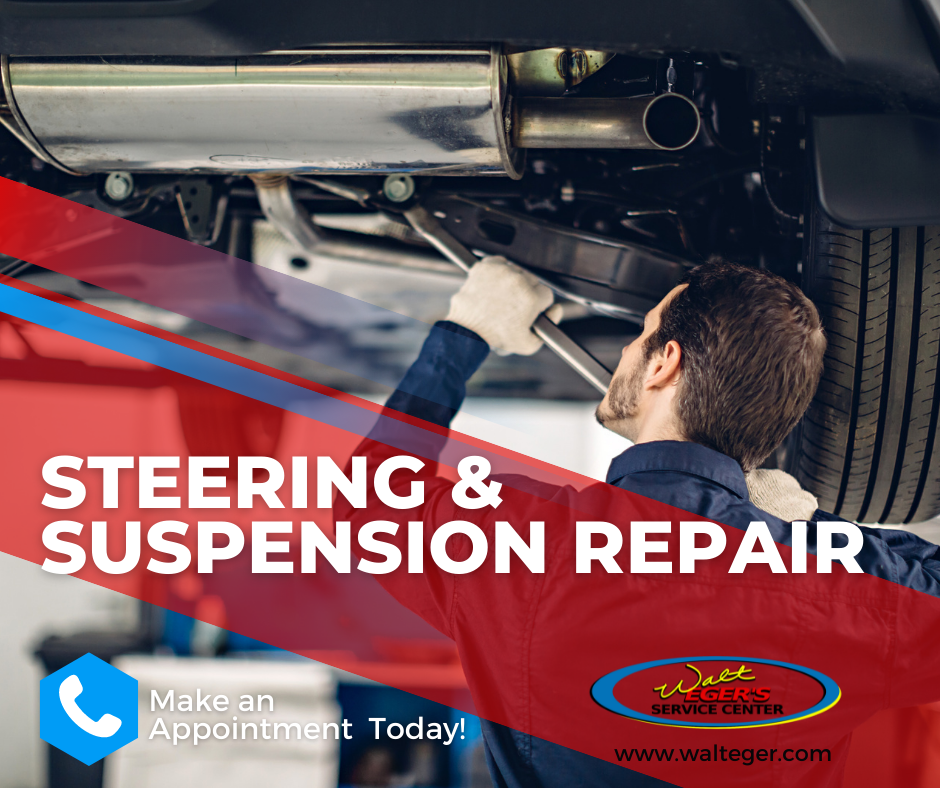 Walt Eger's Service Center is here again with more tips and info on how to keep your ride running smoothly.
Walt Eger's Service Center is here again with more tips and info on how to keep your ride running smoothly. 
Your vehicle's suspension system is the unsung hero that ensures a smooth, comfortable ride and responsive handling. Over time, the various components that make up this intricate system undergo wear and tear. Recognizing when it's time to replace these suspension components is crucial to maintaining your vehicle's performance, safety, and ride quality. In this blog post, we'll provide you with a comprehensive guide to the lifespan of suspension components and the signs that indicate it's time for a replacement.
Before diving into the signs of component wear, let's briefly explore the key suspension components that work together to deliver a comfortable and controlled ride:
1. Shock Absorbers/Struts: These components dampen the impact of bumps and uneven road surfaces, ensuring your vehicle maintains proper contact with the road.
2. Control Arms: Control arms connect the suspension to the frame of the vehicle, allowing for smooth movement of the wheels.
3. Ball Joints: Ball joints connect the control arms to the steering knuckles and allow for controlled movement of the wheels as you steer.
4. Bushings: Bushings are rubber or polyurethane components that provide cushioning and reduce noise and vibration.
5. Springs: Springs support the weight of the vehicle and absorb energy from bumps and road irregularities.
Recognizing the signs of worn suspension components is essential for timely replacement. Here are some indicators to watch out for:
1. Bumpy and Uncomfortable Ride: If your vehicle feels excessively bumpy, even on relatively smooth roads, it's likely that your shock absorbers or struts are worn out.
2. Excessive Bouncing: After hitting a bump, your vehicle should settle within a few bounces. If it continues to bounce excessively, your suspension components may be failing.
3. Pulling or Drifting: If your vehicle pulls to one side while driving or if you experience difficulty keeping it on a straight path, it could be due to worn-out suspension components.
4. Uneven Tire Wear: Uneven wear on your tires can indicate problems with your suspension system, possibly due to misaligned components.
5. Knocking or Clunking Noises: Strange noises, such as knocking or clunking sounds when driving over bumps, can be signs of worn ball joints, control arms, or bushings.
6. Difficulty Steering: Difficulty steering, especially at low speeds, may indicate issues with ball joints or other components affecting steering control.
7. Visible Damage: Inspect your suspension components for visible signs of damage, such as cracks, rust, or leaks.
The lifespan of suspension components varies depending on factors such as driving conditions, vehicle type, and quality of components. As a general guideline:
- - Shock absorbers/struts: 50,000 to 100,000 miles
- - Control arms: 90,000 to 100,000 miles
- - Ball joints: 70,000 to 150,000 miles
- - Bushings: 50,000 to 150,000 miles
- - Springs: Can last the lifetime of the vehicle
Your vehicle's suspension system plays a crucial role in your safety and driving experience. Regular inspection and maintenance are essential to catch worn components before they compromise your vehicle's performance. If you're experiencing any of the signs mentioned above or if you're approaching the component lifespan milestones, it's time to consult a professional mechanic for a thorough inspection and potential replacement. By staying proactive, you'll ensure that your vehicle's suspension continues to deliver a smooth and controlled ride for miles to come.
Whether you're experiencing handling issues, or unusual noises, or simply need a routine suspension checkup, Walt Eger's Service Center is your go-to choice for suspension service near Severn, Maryland. Contact us today to schedule an appointment and experience the difference our expertise can make for your vehicle's performance and your peace of mind.